Wednesday April 2, 2025
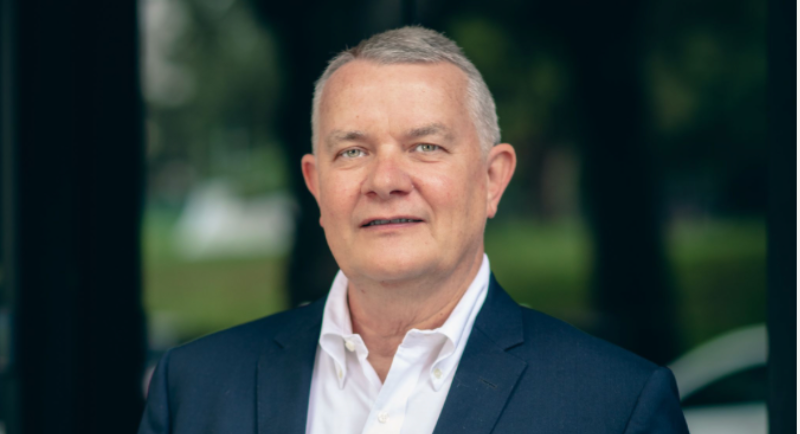
ADMA names former global CMO as advisory board chair, sharpening focus on skills and compliance
The Association for Data-Driven Marketing and Advertising (ADMA) has appointed veteran marketer David Morgan as the new chair of its advisory board, ushering in a leadership shift as the industry body doubles down on upskilling marketers and navigating regulatory change.
Morgan – who has served on ADMA’s board since 2021 – brings over 35 years of global experience, including senior marketing roles at Samsung, Citibank, Procter & Gamble and Nestlé, and a stint as global CMO of Standard Chartered Bank. He is also the founder of consultancy MacMorgan and an educator who has trained over 10,000 marketers worldwide.
He succeeds Steve Brennen, co-founder and CEO of Archie, who is stepping aside after a decade as chair to become ADMA’s vice chair. On his appointment, Morgan paid tribute to his predecessor’s legacy of navigating “ever-changing challenges and opportunities” – from CEO transitions and a merger with the Australian Computer Society (ACS) to the upheavals of COVID and the rise of AI.
“Steve has led the industry capabilities and compliance, setting us all up for success,” Morgan said. “I’m privileged to accept the challenge of the high bar Steve has set, and excited to accelerate ADMA’s strategies for success.”
As the new chair, Morgan signalled his strategic priorities will bolster ADMA’s current direction rather than reinvent it. “We’re not inventing new strategy – we’re doubling down on the current strategies, which is regulation and capability, and we’re going to… drive them hard,” he said at a media roundtable in Sydney.
Morgan’s focus is twofold: helping marketers lead data-driven growth while ensuring they master the “pitfalls of regulation” – such as privacy, data protection and trust – that come with it. At the same time, he plans to amplify ADMA’s push on marketing skills development.
“We’ve got a fantastic tool in the Capability Compass… There’s nothing that exists [globally] to the calibre and quality of what we have,” he said, noting Australia is “punching above its weight” in setting world-class standards for marketing talent.
Ultimately, Morgan argues, these efforts serve a bigger mission of cementing marketing’s role in business: “Marketing is integral – it’s the central function of business success… As marketing is integral to business success, ADMA is integral to marketing success, because we are the first and best leaders in how to build capability and… in regulation.”
Brennen’s decade: guiding marketers through disruption
Morgan’s appointment marks the end of an era for Brennen, who has chaired ADMA’s Advisory Board since 2014. In that time, heoversaw a transformative decade for Australian marketing – one he describes as an “enormous” change with “every marketer facing unprecedented disruption”.
Speaking about his tenure, Brennen said it was “a genuine honour to have been entrusted with the job of helping guide the industry through challenges like COVID, sweeping regulatory reform and rapid digitisation”.
He led ADMA’s evolution from a traditional direct marketing association into a data-driven marketing authority, reflecting how data became “the new currency” for the industry over the last decade.
A key achievement of Brennen’s chairmanship was bolstering ADMA’s voice in policy and compliance. “We saw a lot of regulatory reform… and I think ADMA played a critical role navigating through,” he said. The association worked closely with government on major privacy law updates and helped marketers stay on top of new compliance obligations.
Another legacy of Brennen’s tenure is the Capability Compass, a skills assessment tool developed with top CMOs to identify marketing skills gaps across 13 core competencies. The initiative was born from the recognition of a “capability crisis” in the field, and Brennen has been a driving force behind its development and rollout.
After a long run at the helm, Brennen said he feels ADMA is “in a good place” and that now “it’s about making it happen” – which is why he will remain involved as Vice Chair to support Morgan and ADMA CEO Andrea Martens in the next phase.
Capability and compliance at the forefront
With Morgan and Brennen working in tandem, ADMA is doubling down on two pillars it sees as critical for marketers today: capability and compliance. ADMA CEO Andrea Martens noted that these focus areas “have never been more important” amid an environment of rising complexity.
On the compliance side, Martens observed that marketers are being directly impacted by an onslaught of new regulations and ethical expectations around data.
“We are entering one of the most significant periods of reform the industry has seen,” she said, pointing to the first phase of Australia’s Privacy Act reforms landing this year and growing scrutiny of ethical AI and data use.
“Marketers are now operating in a completely different risk environment than they were 12–18 months ago. Marketers are no longer adjacent to compliance; we are very, very much at the centre of it.”
That shift has spurred ADMA to ramp up its advocacy and guidance. Martens explained that ADMA has been actively engaging with regulators through roundtables, formal submissions, and sharing member insights.
“We’ve built training around privacy, consent, cookies, AI and dark patterns that the industry is lapping up because it’s written… in a way that makes it simple and clear and they can actually apply it in their day-to-day roles,” she said.
Equally urgent is the marketing capability gap. Martens highlighted recent research that revealed a startling deficit in fundamental skills – only 32% of marketers could name the four Ps of marketing, and just 16% could calculate Return on Ad Spend (ROAS).
“It was these sorts of insights that really led us to develop the Capability Compass,” she said. The tool spans 13 core capabilities and 65 specific marketing skills – from insight and strategy through to execution – and delivers a data-driven benchmark of where teams excel and where they are exposed.
Co-developed with top CMOs and supported by Mark Ritson, the Compass is designed to be practical and includes 65 skill-specific toolkits following a 70/20/10 learning model: 70% on-the-job, 20% mentoring, and 10% formal training.
ADMA is now rolling out the Compass across its member base and beyond. Martens said international interest is growing, and global organisations have already begun adopting it. Later this year, ADMA will publish a “state of the nation” report benchmarking Australia’s marketing capabilities across the 65 skills.
“Staying relevant isn’t an option – it’s absolutely fundamental,” Martens said.
Marketers rise to the challenge
Despite the fast-evolving and sometimes daunting landscape, ADMA’s leadership remains optimistic about marketing’s future. Brennen described it as both “the most challenging… and the most exciting” time to be a marketer.
“I think it’s one of the most fun jobs in the world… You have to be on the edge, you have to be learning all the time,” he said.
Martens agreed: “It’s like this complex Rubik’s cube… And when you unlock it, the magic that creates for a business and for the teams is immense.”
With Morgan now at the helm and Brennen still engaged, ADMA is entering its next chapter with a clear mission: to equip Australia’s marketers with the capability, confidence and compliance know-how to thrive in a landscape of constant disruption.

Streaming Wars: How Max plans to win with less content, more engagement
As the battle for streaming supremacy intensifies with the launch of Max, its simple strategy – quality over volume – is getting plenty of attention.
This approach is a key differentiator in the increasingly crowded streaming market, where competition from global and local players is fierce, and aggregation is popular.
As president of Warner Bros Discovery for the APAC region, James Gibbons has launched Max across diverse markets, including Japan and India, but says Australia is a particularly strong market for Max’s premium content offering.
He pledges Max’s success won’t rely on large content libraries but will only produce culturally resonant shows that spark conversation. “Our shows have got to be the ones people talk about. They need to provoke some kind of need to connect with friends or other viewers,” Gibbons says. “The White Lotus is the perfect example.”
“The actual setting of the show is obviously wealthy, privileged people on holiday in a very luxurious location,” he says. “That, in itself, is not something that most of the world experiences, but there are universal themes in the relationships and the characters, and every episode creates conversation.”
Talkability
So all Max needs is a steady stream of content with the same ‘talkability’ as The White Lotus to achieve success?
“Exactly,” says Gibbons, “And the frequency of producing these quality shows is obviously important, if there’s a massive gap between them it’s a challenge for a streaming service, because people don’t have to stay.
“New content is key but we also have a tremendous library of IP and we can create spin-offs. The Last of Us and House of the Dragon are good examples of both of those.”
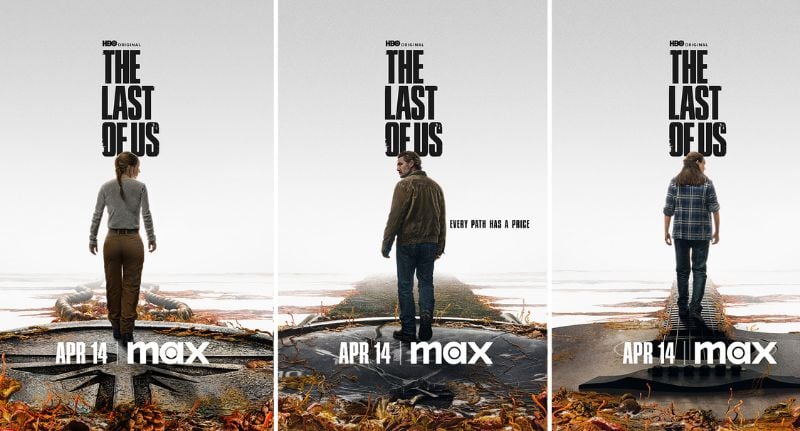
The Last Of Us, Season 2, arrives on Max on 14 April.
Weaving Australian content into this slate is something Gibbons calls the “sweet spot” to success and says it’s Max’s weapon to beat Australian subscriber fatigue.
Australian consumers typically subscribe to only two to three streaming services and customers are becoming increasingly selective about adding new ones to their stack.
“Our sweet spot has to be premium storytelling. That might be scripted or unscripted, but the quality perception must align with what HBO has done with Game of Thrones, Euphoria, or The White Lotus. Whatever we produce locally has to fit that definition.”
Gibbons acknowledges there’s nothing to announce yet but surely it has to happen soon?
“We’re huge fans of Australian content. Our independent TV production unit, led by Michael Brooks, has produced shows like The Twelve and How to Make Gravy, and there is a great appetite for long-running factual series like Aussie Gold Hunters and Outback Opal Hunters.”
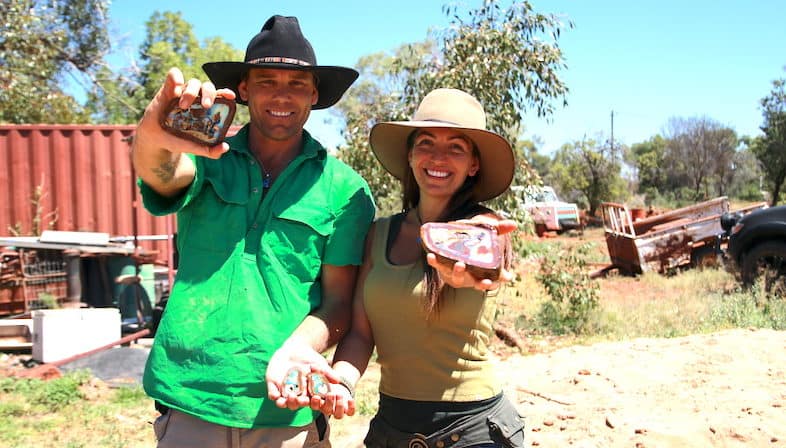
Chris Daff and Sofia Andreou from Outback Opal Hunters.
But will this make the Max profitable within three years as Gibbons’ boss JB Perrette, CEO and President of Global Streaming and Games for Warner Bros Discovery, openly announced at Max’s launch?
Profitability
“We have always been very clear about profitability,” says Gibbons. “If you look at the evolution of the streaming business, for a long time, that wasn’t necessarily a key measure, but it has become one.”
He adds that Max’s launch in Australia aligns with a broader financial strategy. “JB has always said we won’t even launch somewhere if the prospect isn’t within a timeframe, which he has put at three to five years. We wouldn’t have launched in Australia if we didn’t think that was going to be the case.”
And to help it achieve that goal has Max considered acquisitions as part of its strategy?
“What I would say is that we have a full tool kit,” says Gibbons carefully. “We’ll use the right tool at the right time, and sometimes more than one at the same time. Acquisitions are always there as an option, but it’s specific to the situation in each market.”
Key partnerships
Max’s key partnerships in Australia with Foxtel and Nine also play a role in its strategic success, according to Gibbons.
Max’s basic content offering is currently available to Foxtel subscribers at no additional cost.
“Foxtel has been the home of HBO and much of our content over the years, and there’s a very present fan base there. If you already know where your audience is, why would you necessarily spend extra money to reach them in some other way?” he says reasonably.
With Nine, Max is tapping into a well-established advertising infrastructure.
“We already have a joint venture with Nine – Nine Rush – and they sell some of our content. So adding Max on was a straightforward step.
“Advertising is vital for premium streaming,” he acknowledges. “To reach a whole market, you need pricing at a lower point, and to make that viable, there needs to be another income stream. That’s where advertising comes in.”
If Gibbons makes the job of hitting Perrette’s profitability target sound straightforward, he admits that’s not his intention, particularly the challenge to produce the right content to keep the Australian audience subscribing.
“Our job is to make sure we deliver and I don’t think any of us underestimate that. I know how big a job it is. It’s easy to say, but to do it month in, month out, it’s a challenge, but I think everyone’s up for it,” he says.
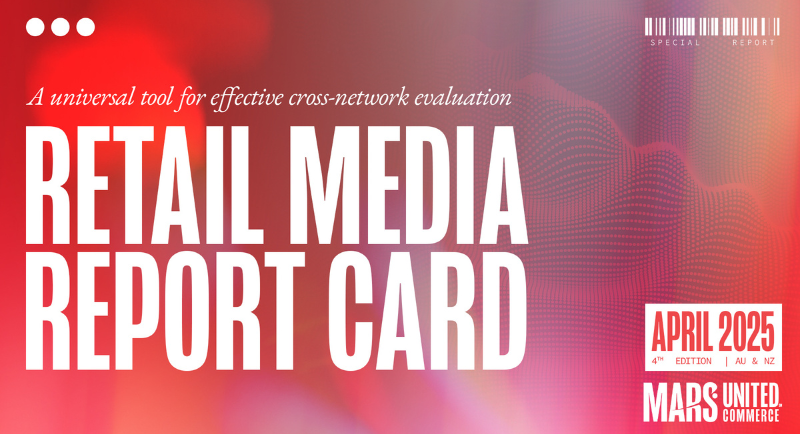
Mars United Commerce ANZ Retail Media Report Card ‘reflects a category that’s maturing fast’
Mars United Commerce, part of Publicis Groupe, has released the fourth edition of the ANZ Retail Media Report Card, revealing the new capabilities that highlight evolving expectations of brands in retail media.
The report aims to help brands build a clear understanding of the market dynamics influencing retail media.
Cameron Porter, commerce planning director at Mars United Commerce ANZ, told Mediaweek the report card reflects a category that is “maturing fast”.
He noted that with the 17 additional capabilities (now a total of 80), including self-service, IAB Measurement Compliance, and audience-level targeting, there is a sense of momentum.
“Brands are pushing the boundaries with test-and-learns, new formats like digital and delivery sampling, and bespoke off-toolkit opportunities. Even where execution still has room to grow, the ambition is clear — there’s a growing confidence in retail media’s potential.
“Ultimately, the Report Card reflects a category that’s maturing fast. The goal is clear: connect the path to purchase through smarter, shopper-led media placements and creative commerce, and prove that it delivers results.”
New capabilities and additional entrants
The bi-annual report provides brands and agencies with insights into the 17 new capabilities, including targeting, innovation, measurement, media opportunities, and partnerships.
It also evaluates new entrants such as Uber Advertising, Adore Beauty Media and AVC Experience Plus, alongside established networks such as Cartology, Market Media, Amazon Ads and Coles 360.
Porter said each of the new players brings a different proposition to reshaping the ANZ retail media landscape, making them interesting as they expand the definition and competitive dynamics of retail media in the region and accelerate innovation.
“With every new launch, the definition of retail media shifts, and so does the value proposition. That’s only going to accelerate innovation.”
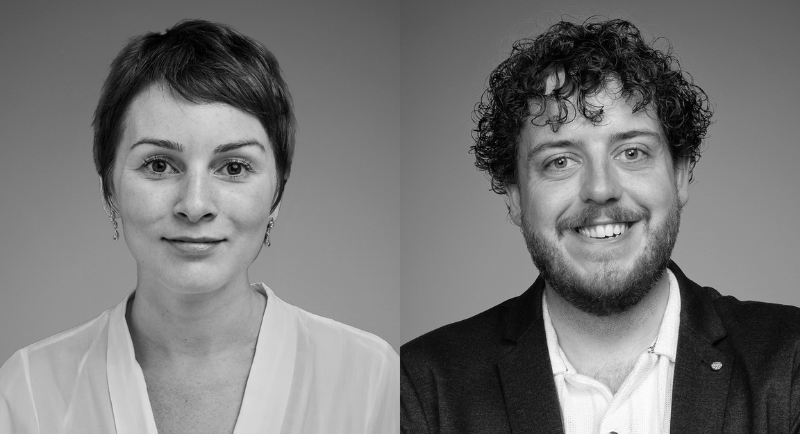
Kelly Wearmouth and Cameron Porter
‘There’s still plenty of room for innovation’
While there are more and more retail media networks launching, Kelly Wearmouth, managing director of Mars United Commerce ANZ, told Mediaweek there is plenty of room for innovation.
“If anything, the increasing competition is accelerating it.”
“New networks are opening the door for smaller or emerging brands to explore retail media in ways that were previously out of reach. It’s helping democratise access.”
“Yes, some networks may struggle if they don’t evolve to meet expectations, but that pressure is pushing the entire ecosystem to deliver faster, smarter, and more data-informed solutions.”
Wearmouth pointed out that not every brand has the same needs.
“For example, when a new product launches exclusively at one retailer, brands need a way to connect directly with that retailer’s shoppers. Saturation looks very different depending on the lens you’re using.”
‘Relevant placements are what makes the platform so powerful’
The State of ANZ Retail Media report highlighted the rise of non-endemic brands in high-purchase-intent environments.
Porter noted that non-endemic brands were “seeing real results” from leaning into contextual targeting and themed audiences.
Wearmouth pointed to Amazon as an example and said it came down to signal strength.
“Take the growth of Prime Video – it’s being significantly fuelled by non-endemic brands and it’s because of retail media’s ability to provide relevant signals, whether on platform or not, that provides a ripe opportunity. Their ability to match intent data with relevant placements is what makes the platform so powerful.”
Porter added that there is also momentum through experience-led environments such as David Jones and AVC Experience Plus.
“Both offer access to premium, lifestyle-focused audiences in high-dwell settings, creating opportunities for non-endemic brands to align with occasions and environments their shoppers already love.
“Whether it’s through curated retail displays integrating the much-loved David Jones brand or contextually relevant venues at AVC, these formats allow brands to build meaningful associations with targeted customers, even when the product isn’t on the shelf.”
Top image: Kelly Wearmouth and Cameron Porter

‘A bit more pessimistic’ and ‘nothing worth celebrating’: Darren Woolley gives stark analysis on the 2025 State of The Pitch
“There’s a theme running through this report: pitches being used for a cost reduction tool. A lot of focus is on the price of agencies, or the cost of the agencies, rather than necessarily the best agencies,” Darren Woolley, global CEO of TrinityP3, told Mediaweek as the pitch consultancy releases its second State of the Pitch report.
For Woolley, the industry has not made significant improvements since the initial 2024 findings. The agencies that participated in this year’s survey participated in 70 pitches from July to December 2024.
‘It’s a bit more pessimistic than it was last year’
This year’s State of The Pitch report, which saw the surveyed agencies take part in 70 pitches from July to December 2024, highlighted an overall decline in pitch satisfaction, with the average pitch rating dropping from 3.13 out of 5 last year to 2.99.
Woolley noted that there was nothing worth celebrating.
“When you look at the number of agencies that weren’t successful this time, last year it was 44%. This year it’s 30%. We’ve got a lot more agencies this time that didn’t win. When you look at the scores that they gave, winning certainly made them feel better about the process.
“In the sample, there is a reason why it’s a bit more pessimistic than it was last year. But the actual reasons for the types of things they’re pessimistic about are cost-focused.”
Woolley highlighted a prime example of this was the growing number of extended payment terms, citing the rise in 31-to-60-day remuneration periods jumping from 19.50% last year to 51.40% in the current survey.
“There’s very much a trend towards putting the financial pressure on the agencies and not on the clients. And you would have to say the state of the economy is having an impact there.”

Darren Woolley
It’s all about the money
Uncertainty in the economy over the last year has been the contributing factor to dissatisfaction in the pitch process as budgets tighten, brands look to save more and marketers want to pay less.
“I don’t think there’s a marketer around that would tell you they have enough budget to do everything they need to do. If they can find ways of saving money so that they can do more, then they’ll do it.
“Whereas procurement will be trying to save money so they can return to the bottom line.
Woolley said that while they each have very different motivations, marketers and procurement are focused on cost reduction, which is highlighted in the survey.
Still boiling the ocean
In the 2024 State of The Pitch report, Woolley told Mediaweek that marketers are “boiling the ocean” to find the right agency, and the statement still holds true in this year’s findings.
“What we did notice this time was that there were more pitches for very specific roles, like social media influencer, a production agency, pitches for digital agencies, digital/technology suppliers.”
He noted that pitch lists continued to include long consideration lists, though not as gargantuan as 45 agencies in a pitch, as reported last year. Woolley said: “To start with more than 13, that is still boiling the ocean. It’s not as widespread as it was last year, but it’s still present.”
Woolley said a lot of work still needs to be done on improving the pitching process to make it fit for purpose.
“It’s still got a long way to go. There still could be a place, occasionally, for running pitches the way they’re being run at the moment. But that should be in the minority, not as the standard approach.”
Where did the industry go wrong?
“The industry hasn’t changed for the changing requirements,” Woolley said.
He noted the changes in marketing, media and advertising over the last decade greatly contrast the lack of change in the process and requirements in pitches.
“The fact that there’s still so many pitches that require speculative, creative work, it’s just crazy. In most cases, you’re appointing people to do lots of different campaigns, and lots of different ideas, not just come up with one.
“The fact that agencies keep lining up for full pitches, whether it’s for a $50,000 project or a $10 million contract, regional or global contract.
“For an industry that prides itself on creativity and innovation, the pitch process is largely stagnated and hasn’t changed in the last 20 years,” Woolley said.
ESG and DEI: ‘They’re important for business’
The State of the Pitch report also interrogated ESG and DEI compliance and highlighted how it has become less of a priority for consultants and procurement, in contrast to marketers which has shown slightly better figures.
Woolley shared two theories, the first being clients shifting focus to saving money rather than compliance to modern slavery, zero net emissions, DE&I and gender equality commitments.
The second is the rise of the anti-woke movement in the US, which he noted appears to have already had an impact.
“There’s more of a focus on price, delivering savings rather than worrying about risk mitigation around issues like gender equality and DE&I”.
Woolley said some agencies are already leaning into the anti-woke movement and withdrawing DE&I initiatives to keep government business.
“I think there’s a real risk that this move away from doing the right thing, for very good reasons, is becoming a negative. I think that’s a worry for anyone because zero net emissions are more than just saving the planet. It’s also making your business much more effective.
“Diversity, equity and inclusion are not just giving a fair go. It’s also building creative and innovative companies through having a diversity of ideas and opinions. Gender equality is about increasing the pool of talent by 50% by giving everyone the opportunity to perform.
“All of these things are not just things that we should do to feel good or to be good, but they’re also important for business.”
What agencies, marketers and procurement teams need to consider
Woolley noted that marketers and procurement teams need to think about what they are trying to achieve before they go to pitch. He said that comments about going to pitch to see what else is out there are “incredibly wasteful”.
“They need to consider why they’re going to pitch, and have they designed a process that is the best way to achieve what they’re trying to achieve.”
Meanwhile for agencies, Woolley said they need to think hard about the pitches they are willing to participate in. He encouraged them to understand what the pitch was about before throwing their hat into the ring.
“Agencies need to interrogate the pitch process more and decide whether this is something they want to participate in.”
Woolley highlighted that the nature of the pitch process has shown the negative sides of both marketers and procurement, as well as agencies.
He noted that marketers have relied on agencies turning up to take part in pitches while agencies have been left feeling jaded and deceived by the experience.
One respondent quoted in the report called the process “deceptive”, “unethical”, and “wholly unacceptable”, and that they would blacklist senior executives and procurement and never do business with them again.
“This is the level of anger and resentment that badly run pitches deliver,” Woolley said.
Outlook of trends for the next State of The Pitch report
Looking ahead with predictions for the next report, Woolley highlighted the high level of pitch activity in the market for the first half of this year.
“It’ll be interesting to see if that continues through to the second half of the year.
“I suspect the only thing that could stand in the way, particularly on global pitches is the uncertainty around things like tariffs and the global economy’s response to what the US government’s doing.”

Government ad spend continues to ramp up as election date now set
Australian advertising demand continues to recover, with Guideline SMI’s latest data revealing February ad spend was down just 0.5% year-on-year. This is a strong showing in a market now clearly influenced by the upcoming Federal Election.
Among major media channels, Outdoor continued its winning streak with the highest dollar growth (+9.2%), followed by Radio (+3.4%) and Newspapers (+2.4%). Cinema recorded the largest percentage uplift of nearly 21%, while Digital bookings were still tracking 3% down, pending late Search and Programmatic additions, which may yet push February into the black.
Guideline SMI APAC managing director Jane Ractliffe said the imminent Federal Election was the major driver of February’s uplift, with Government category ad spend soaring 46% year-on-year, adding $12 million in extra demand.
“SMI’s Forward Pacings data shows now that the election has been called, spend is shifting from the Government category into Political Parties and Industry Associations, particularly in March and April,” Ractliffe said.
“We’re already seeing an extra $8 million committed to TV by Political Parties in March and another $6 million in April – pushing total March ad demand ten percentage points higher than this time last year.”
When the additional Government spend is stripped out of the February total, the underlying market was down 2.7% YoY. Still, Outdoor remained a standout performer (+8.7%), and press stayed marginally positive (+0.7%).
Beyond government, Insurance brands also lifted their presence (+15.1%), while the Household Supplies category surged a massive 64% YoY. However, the Automotive category continued to weigh down overall results, declining 10%.
The February 2025 figures mark a noticeable turnaround from the same month last year, when ad spend fell 6% YoY. At that time, Digital was down 3.1%, TV dropped 13%, and Outdoor showed only marginal resilience, off 0.4%. This year’s near-flat result, bolstered by election activity and stronger media sector performance, suggests stabilisation and renewed momentum in the market.
For the financial year to date, the market has now moved back into positive territory (+0.5% YoY), buoyed by strong performances in Digital (+5.8%), Outdoor (+4.7%), and Cinema (+10.5%).
Across the Tasman, New Zealand continues to show even stronger momentum. February marked the fourth straight month of ad growth, with spend up 4.2% YoY. Outdoor rose 22.8%, and Radio lifted 16.8%.
“The New Zealand market is finally shaking off its post-COVID slump and is now delivering sustained growth,” Ractliffe said.
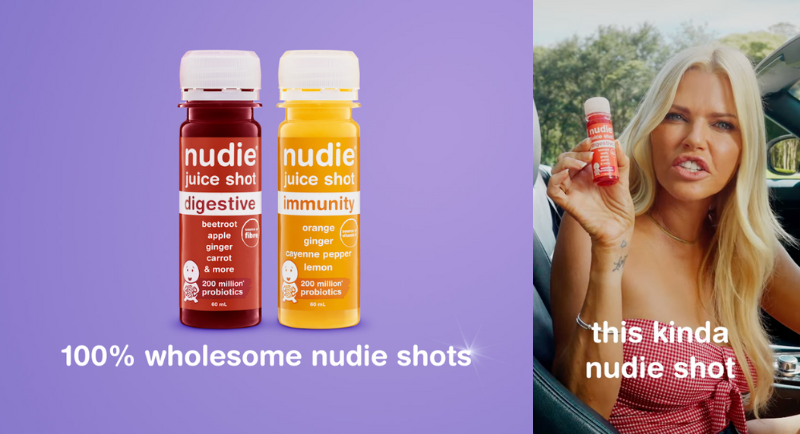
Sophie Monk shows off ‘100% wholesome nudie shots’ via Bench Media and Circul8
Juice brand nudie has teamed up with Sophie Monk for a cheeky new campaign, ‘100% wholesome nudie shots’.
Developed by media agency Bench Media and creative agency Circul8, the campaign sees Monk show off nudie shots across social channels.
While a ‘nudie shot’ normally comes with a content warning, but the nudie juice shot range is designed to support a healthy lifestyle on the go. The 60ml juice shots contain nothing but real ingredients with pre- and pro-biotics that support immunity, digestion and overall wellness.
“We’re beyond proud to launch this campaign with the one and only Sophie Monk,” Emilie Durand, head of nudie brand (Juice) said. “Her cheeky humour is perfect for giving Aussies a nudge to take their health seriously – just not too seriously.
“The campaign is all about shaking up the functional drinks space, making wellness fun, effortless, and ridiculously tasty. This is one nudie shot nobody will regret!” she explained.
The campaign kicks off with a OOH teaser campaign across high impact poster sites in Sydney and Melbourne with Monk introducing the new nudie shots to her social media followers.
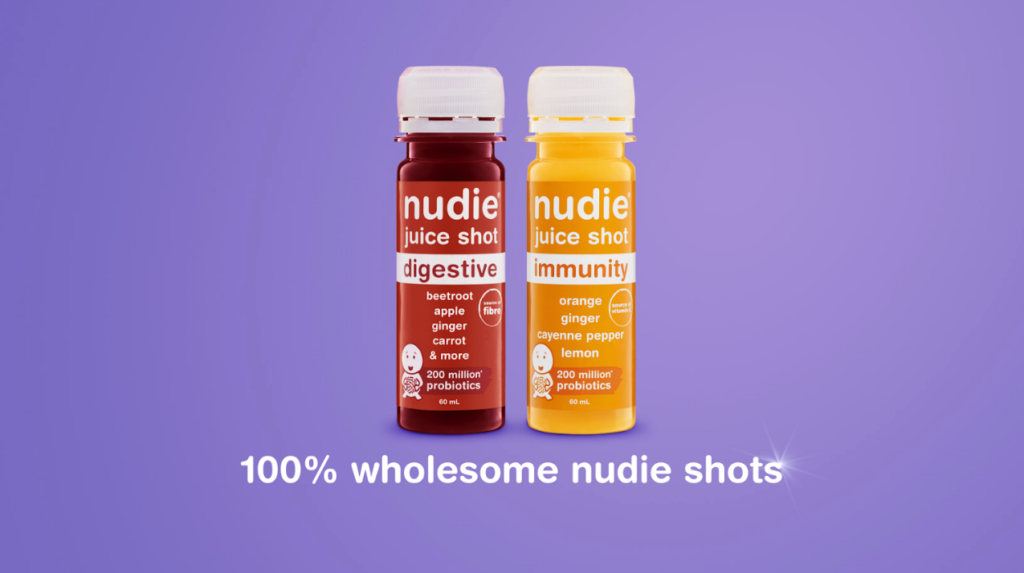
The teaser campaign sets the stage for a broader paid media rollout across Meta and TikTok to amplify engagement and drive excitement and awareness among target audiences.
Out-of-Home screens will be used near key retail locations to drive impulse purchases during grocery runs. Additionally, strategic placements in fitness centres will connect with health-conscious Aussies in a fitting environment.
Nate Vella, brand strategy lead at Bench Media, said: “We’ve been delivering effective and innovative media solutions for nudie for almost three years now.
“This campaign launch is an important new product offering for nudie and the media strategy and execution have been built around the audience to maximise impact and engagement with the creative idea, from street posters through to OOH and social.”
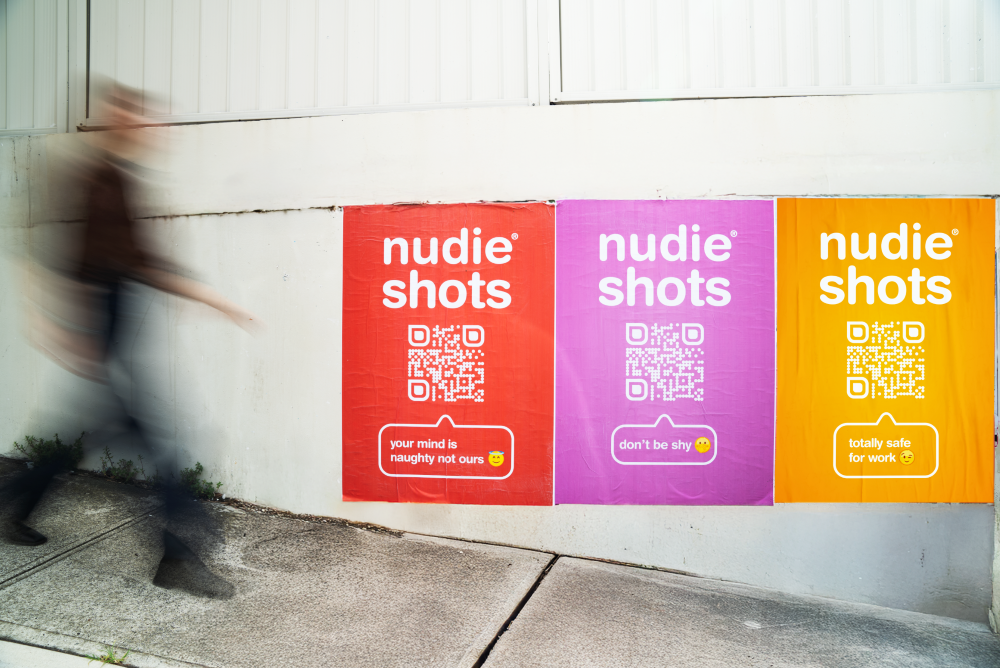
Alana Stocks, founder and managing director, Circul8, said: “We know it’s harder than ever to get people’s attention, especially in social. But we also know humour and fame cuts through.
“This campaign is the perfect blend of the cheeky tone nudie is known for, delivered by the perfect person for the job Sophie Monk. This is the first of many great campaigns to come since winning the pitch for the nudie business earlier this year.”
The campaign runs from 2 April to 30 June, just in time for a health boost before the colder months to keep those winter nasties at bay.
Credits
Brand: nudie
General Manager: Samantha Hutson
Head of Brand (Juice): Emilie Durand
Brand & Creative Manager: Amarna Jones
Media Agency: Bench Media
Brand Strategy Lead: Nate Vella
Performance Project Lead: Jamison Milessis
Creative Agency: Circul8
Founder & Managing Director: Alana Stocks
Creative Strategy Partner: Phil Watson
Head of Operations & Delivery: Audrey Wigsten
Head of Digital & Design: Neil Neelan
Cinematographer: Jarryd Sinclair
Digital & Social Media Manager: Kate McGregor
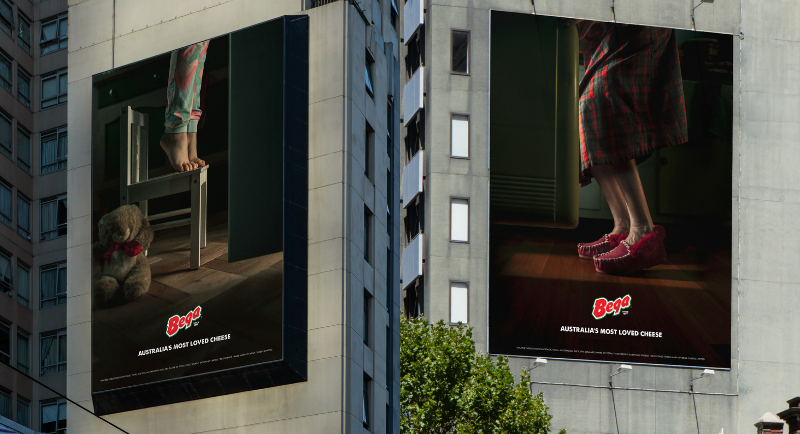
Bega unveils ‘Night Cheese’ OOH campaign via TBWA\Melbourne
Bega has launched its ‘Night Cheese’ campaign, created in collaboration with creative agency TBWA\Melbourne.
The campaign sets out to establish a brand-new snacking occasion for cheese lovers across the nation. From a cheese toastie to the main feature of the lunch box, cheese brands typically focus their marketing efforts around daytime occasions.
Bega Cheese, a leader in the category, recognised the need to disrupt these moments in order to not only sustain but grow market share.
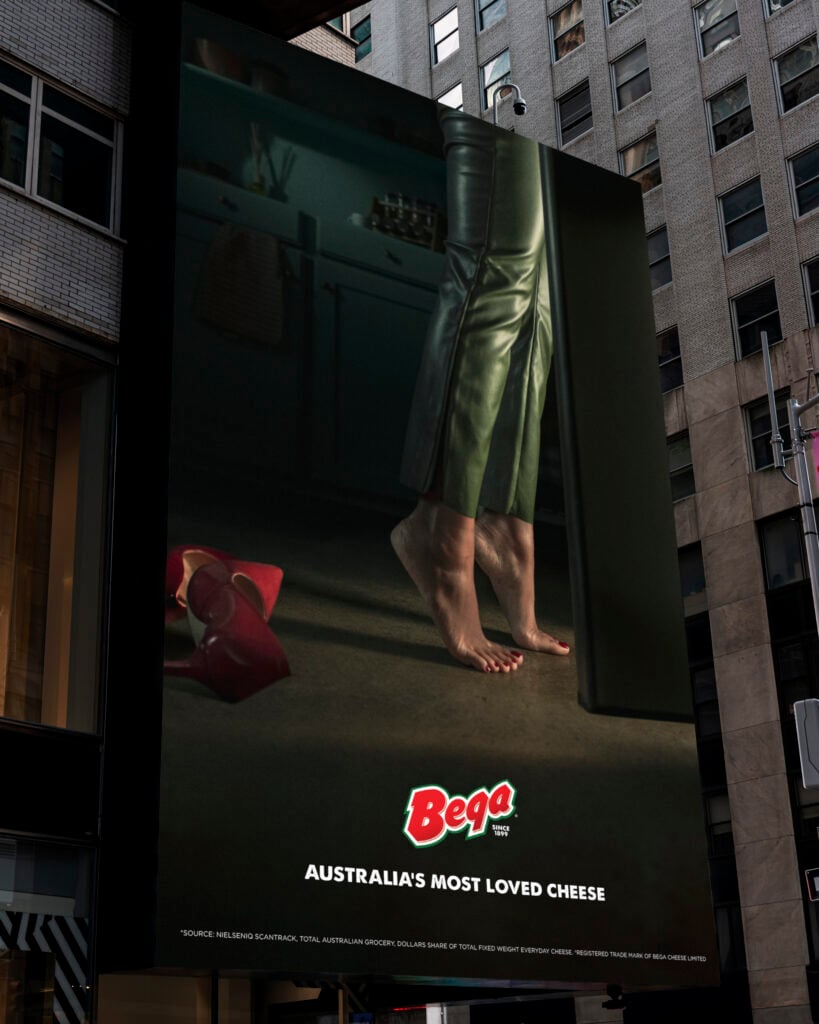
Research and consumer insights highlighted a gap in the cheese market: the cheeky late-night snack. Breaking away from traditional dairy cues of conventional product, food and recipe-based creative.
The new large-format OOH campaign features the iconic image of a person opening the fridge in the quiet of the night — a universal moment of craving we’ve all been guilty of.
“By identifying and owning the late-night snacking moment, we are creating a whole new experience of indulgence that is uniquely Bega,” Bianca Di Donato, marketing manager, Fonterra Oceania, said.
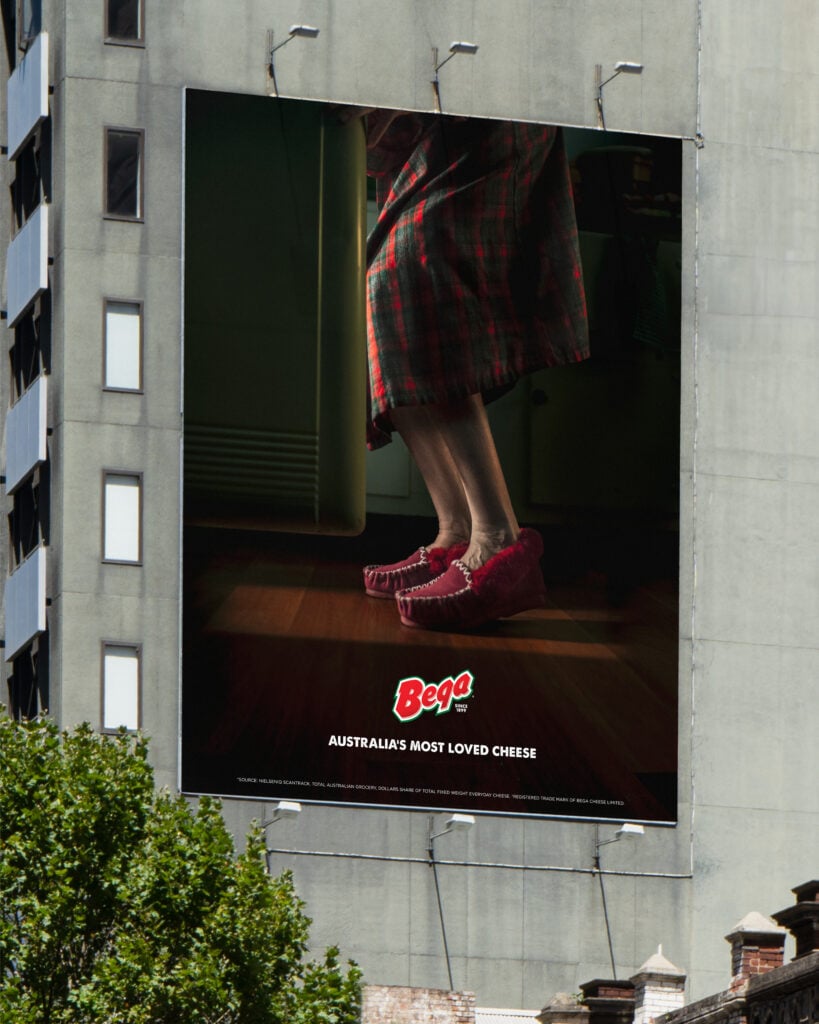
“We love how the beautifully striking yet simple photography uses Bega cheese cues to activate the audience’s memory structures whilst inviting them in to fill in the blanks.”
Paul Reardon, chief creative officer, TBWA\Melbourne, added: “We heard a stat that Bega cheese is in one out of every two household fridges in the country. That’s a great reason to act like a brand leader, with something super simple and confident, without all the conventional foodshots, food packs, products range, etc.
“By our logic, in Australia, 50% of us have, at some point, raided the kitchen fridge late at night for Bega cheese. It’s a weird thing we do — a little moment we thought was worth showing.”
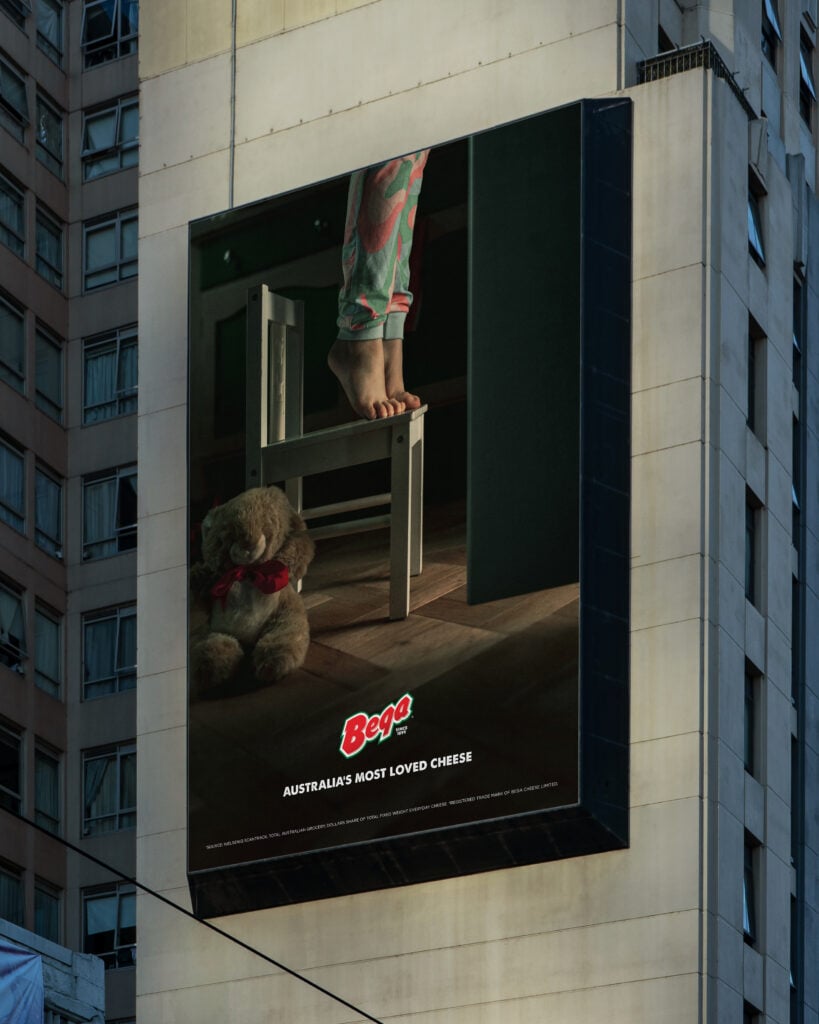

The AI apocalypse for publishers isn’t coming – it’s already here
Just like 2024 the start of 2025 has delivered a bruising start for Australian media. Job losses across major outlets paint a stark picture: Nine cutting up to 200 roles, Seven reducing 150, and ACM winding back its print operations and shedding 35 editorial positions.
Pedestrian TV, part of Nine, underwent a restructure that could affect around half its workforce. News Corp, meanwhile, is eyeing $65 million in cost savings with accompanying cuts. The ripple effects are far-reaching – from regional newsrooms to capital city mastheads.
But this isn’t just about headcount. It reflects a deeper existential challenge for publishers: the rapid rise of generative AI, which is shifting how audiences access content and, critically, how traffic flows online.
Tools like ChatGPT, Google’s Gemini-powered AI Overviews, Perplexity and others are reshaping the landscape. While these platforms promise convenience for users, they risk hollowing out the discoverability of independent media by serving AI-generated summaries instead of surfacing publisher links.
Publishers, particularly smaller independents, face the double threat of diminished visibility and their content being used to train these models – often without consent or compensation.
It all sounds fairly grim, doesn’t it? But here’s the twist: I don’t think it has to be.
The AI “apocalypse” is real, yes – but it’s not the end. Rather, it’s a wake-up call. And if publishers can pivot quickly and smartly, there are plenty of opportunities to not just survive but actually grow stronger in this new paradigm.
1. Reclaiming Direct Relationships
The first step is to stop relying so heavily on platforms like Google and Facebook for reach. That era is over. Publishers need to invest in owned channels – newsletters, podcasts, mobile apps, community hubs – where they can connect directly with their audience without the middlemen.
At Man of Many, for instance, we’ve doubled down on our newsletters and video. We’re also investing in subscription products and developing community-led experiences – not just chasing the next click, but building deeper loyalty over time.
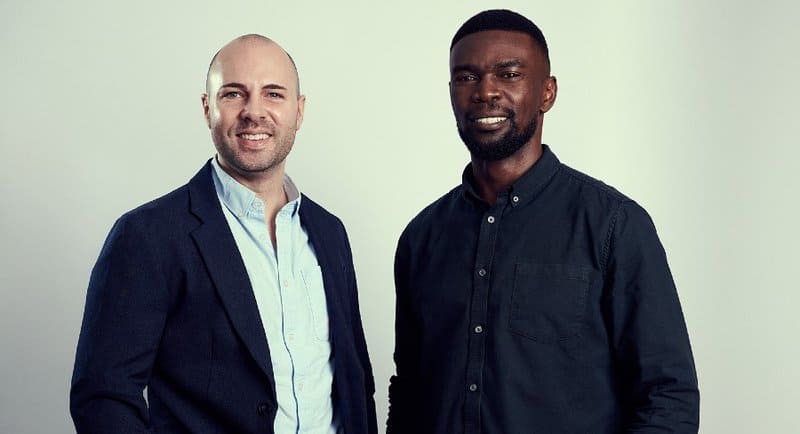
Man of Many co-founders Scott Purcell and Frank Arthur
2. Build for AI Discovery
AI search isn’t going away – so it’s time to optimise for it. Publishers should think about Generative Engine Optimisation (GEO), not just SEO. That means structuring content for clarity and authority, targeting informational queries, and ensuring schema markup and data hygiene are in place so AI systems can understand and attribute content correctly.
Clear, structured, helpful content will be key to staying visible in this new ecosystem.
3. Create Unreplicable Value
The best way to future-proof your content? Make it human. AI can summarise, remix and recycle – but it can’t replicate lived experience, local knowledge, deep investigation or a distinctive editorial voice. Whether it’s on-camera personality, analysis with actual nuance, or journalism that exposes uncomfortable truths – original content remains the most valuable currency in publishing.
4. Use AI Strategically, Not Unthinkingly
There’s a place for AI inside newsrooms – not to replace journalists, but to help them move faster and smarter. From automated transcripts and summaries to internal tools like Google’s Vertex AI or newsroom integrations like the NYT’s Echo, publishers should adopt AI to reduce inefficiencies while setting clear editorial boundaries.
Publishers should set clear internal policies to manage how AI is used responsibly, preserving editorial integrity while embracing the efficiencies it offers.
5. Advocate for Fairness
Lastly, we need to keep the pressure on. AI companies, platforms and governments must be held accountable to ensure publishers are compensated fairly, through transparent licensing agreements, protections against content scraping, and visibility into how AI tools source and display media.
This isn’t just a publisher problem – it’s a critical issue for agencies and advertisers too. Without a sustainable ecosystem of independent media, brands will have fewer credible, trusted environments in which to promote themselves. The halo effect of advertising alongside quality journalism is well-documented, yet budgets continue to funnel into closed platforms, starving the very outlets that deliver impact and trust.
Agencies and brands have a real role to play here by actively rebalancing spend and building direct partnerships with publishers. Because if we lose these voices, we don’t just lose journalism – we lose one of the last brand-safe spaces in digital media.
These are not quick fixes. But they are necessary shifts. If publishers can embrace them, there’s real potential not just to survive this transformation – but to come out of it stronger, more independent, and more valuable than ever before.
For more in-depth research, analysis, data and commentary, you can read the full article here: https://www.linkedin.com/
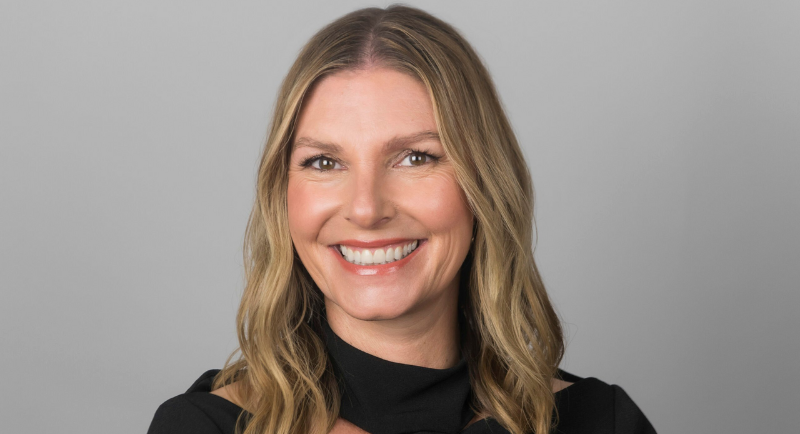
OMA Creative Awards debuts with lively jury discussion and Cannes prize
The inaugural OMA Creative Awards, organised by the Outdoor Media Association (OMA), have sparked lively discussions within the out-of-home (OOH) advertising industry.
Ahead of the winners being announced on Friday, the entire jury gathered to debate the winners of the seven categories, providing an opportunity for industry leaders to discuss the creativity and impact of this year’s entries, and the medium as a whole.
“I wanted the jury to be together and not voting online,” OMA CEO Elizabeth McIntyre told Mediaweek. “I’m trying to engage with the creative community and I wanted to start discussions that can continue from here.”
This approach allowed the jury to look at the entries within the wider context of the evolving role of creativity in the OOH space and the innovative ways brands are using outdoor media.
McIntyre, who took the helm at OMA in April 2023, has been the driving force behind the awards. “They were something I wanted to do since I first started at OMA,” she explained.
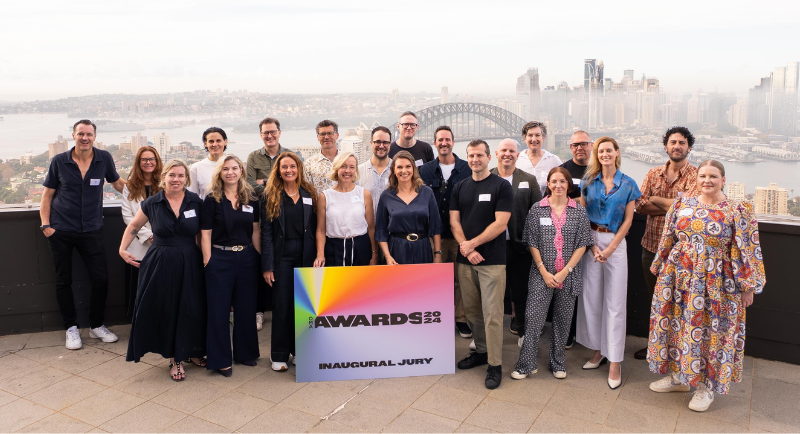
The inaugural OMA Creative Awards jury.
Originally planned for a 2024 launch, the awards were strategically scheduled for 2025 instead. “We looked at launching at the end of last year, but by launching it now, we can include submissions from all across last year, which has been great,” she said.
The enthusiasm surrounding the awards has exceeded expectations, with an impressive number of high-quality entries.
“In fact, we’ve been so blown away with the number of entries and their quality, we might try and start running the awards every six months to keep the work fresh,” McIntyre revealed.
Entries have been judged by a distinguished panel of senior creatives, marketers, and industry experts, highlighting the depth of talent and innovation within the OOH sector.
“On the jury there were creatives plus CMOs,” said McIntyre. “And I really wanted the marketing experts there because they give context. It’s all very well to submit a great campaign, but creativity comes at a cost and I wanted other voices in the room to know what was involved in every aspect of it.”
But while McIntyre admits the quality of the work submitted was exceptional, there was one category she felt she would have liked to see more entrants – Best Small Format Campaign.
“I thought it was under-represented,” she said. “But I think that that’s just an education piece for the next awards.”
Grand Prix winner’s prize
Along with the individual category winners, there will be one overall winner of the Grand Prix, with that creative team winning a trip to the Cannes Lions Festival of Creativity in June.
As a result the jury had very lively conversations about who should win.
“It was really contested,” says McIntyre. “There was a very robust discussion with that Grand Prix winner and also the Classic Campaign, but that’s exactly how it should be – and that’s the feedback from the jury too.”
“I loved some of the comments during the judging which were things like, ‘It’s just not enough just to redo a bus shelter’ and emphasising how when an OOH campaign hits the mark, it hasn’t always been recognised and it should be. These awards are a way of doing just that.”
The winners will be announced on Friday 4 April in Sydney.
The awards come just weeks before McIntyre and the OMA present the new version of MOVE to the industry – the audience measurement platform of OOH.
Powered by millions of data points, updated MOVE technology will capture “how, why, where and when people move, season by season, 365 days a year, across all metro and regional Out of Home formats.”
2024 OMA Creative Awards Finalists
Best Classic Campaign
Campaign: Black Friday Sale
Advertiser: Kitchen Warehouse
Agency: Special Group
Campaign: From Space to Your Place
Advertiser: Telstra
Agency: +61
Campaign: Welcome to Melbourne
Advertiser: Specsavers ANZ
Creative: TBWAMelbourne
Best Digital or Programmatic Campaign
Campaign: Billboard Breakthroughs
Advertiser: NIB
Creative: Dentsu Creative
Campaign: Storm Season
Advertiser: Suncorp Insurance
Creative: ArtBot
Best Innovation or Sustainability Campaign
Campaign: The Fall Guy – Death-Defying Live Action Billboard
Advertiser: Universal Pictures
Creative: Universal Pictures
Campaign: Healthier Ways
Advertiser: Zespri Kiwifruits
Creative: Dentsu Creative
Best Small Format Campaign
Campaign: Ban the Burn
Advertiser: Ocean Spray
Creative: The Reactor
Campaign: Banana Gym Pass
Advertiser: Australian Bananas/Hort Innovation
Creative: Thinkerbell
Best Multi-Format Campaign
Campaign: Black Friday Sale
Advertiser: Kitchen Warehouse
Creative: Special Group
Campaign: Welcome to Melbourne
Advertiser: Specsavers ANZ
Creative: TBWAMelbourne
Best Special Build Campaign
Campaign: Holiday Special Builds
Advertiser: Amazon XCM
Creative: Amazon & MBCS
Campaign: Black Friday Sale
Advertiser: Kitchen Warehouse
Creative: Special Group

TV Ratings Monday 31 March 2025: Married At First Sight stays strong
Total People TV Ratings
Nine’s Married At First Sight recorded a total TV national reach of 2,737,000, a total TV national audience of 1,753,000 and a BVOD audience of 448,000.
Seven Seven News recorded a total TV national reach of 2,228,000, a total TV national audience of 1,407,000 and a BVOD audience of 89,000.
Nine’s 9News recorded a total TV national reach of 2,155,000, a total TV national audience of 1,337,000 and a BVOD audience of 127,000.
Nine’s A Current Affair recorded a total TV national reach of 1,960,000, a total TV national audience of 1,257,000 and a BVOD audience of 135,000.
Seven’s Australian Idol recorded a total TV national reach of 1,641,000, a total TV national audience of 1,022,000 and a BVOD audience of 95,000.
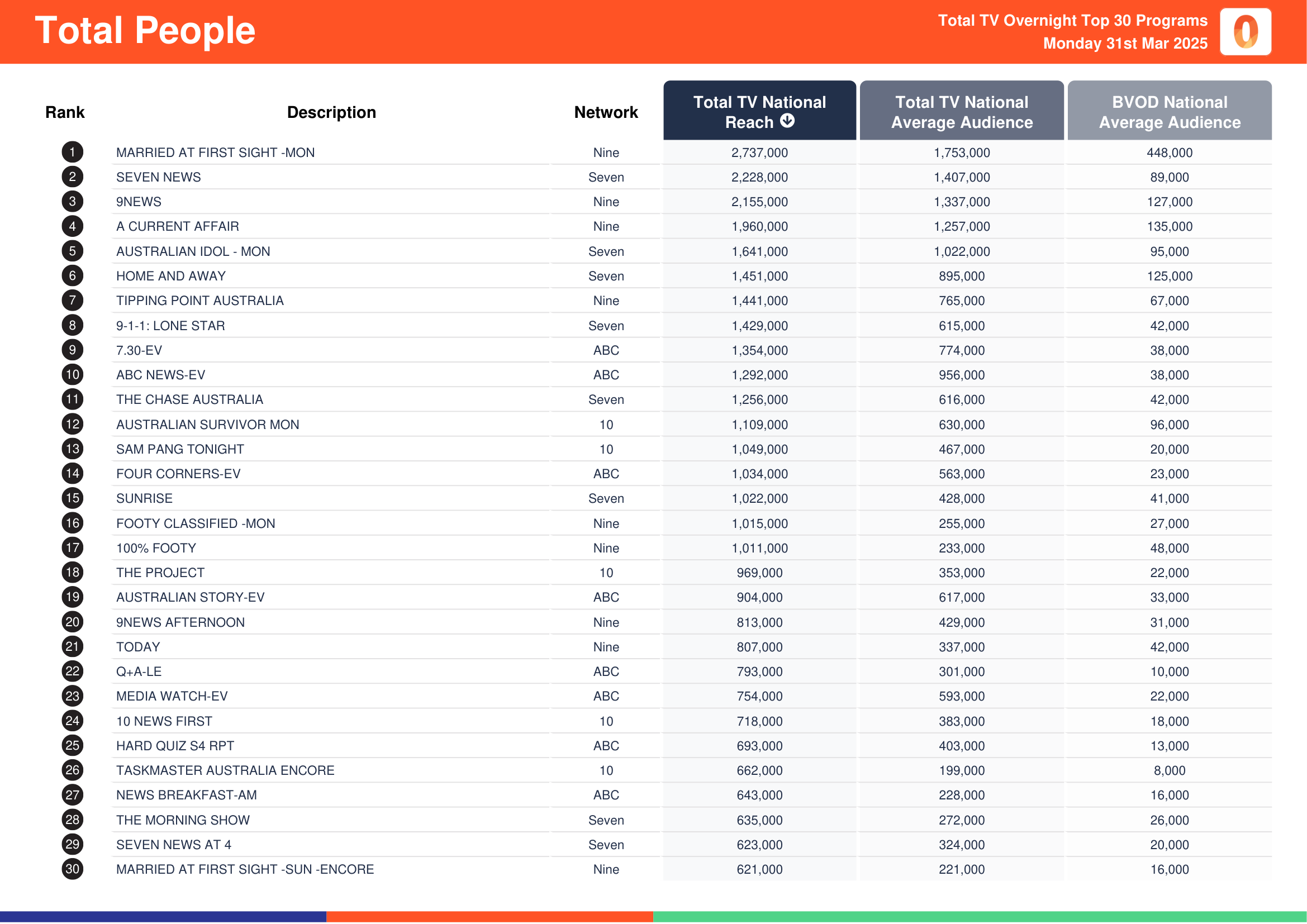
Total People 31 March 2025.
People 25-54
Nine’s Married At First Sight:
• Total TV national reach: 1,171,000
• National Audience: 815,000
• BVOD Audience: 280,000
Nine’s A Current Affair:
• Total TV national reach: 688,000
• National Audience: 403,000
• BVOD Audience: 76,000
Nine’s 9News:
• Total TV national reach: 676,000
• National Audience: 399,000
• BVOD Audience: 66,000
Seven’s Seven News:
• Total TV national reach: 561,000
• National Audience: 324,000
• BVOD Audience: 45,000
10’s Australian Survivor:
• Total TV national reach: 516,000
• National Audience: 323,000
• BVOD Audience: 58,000
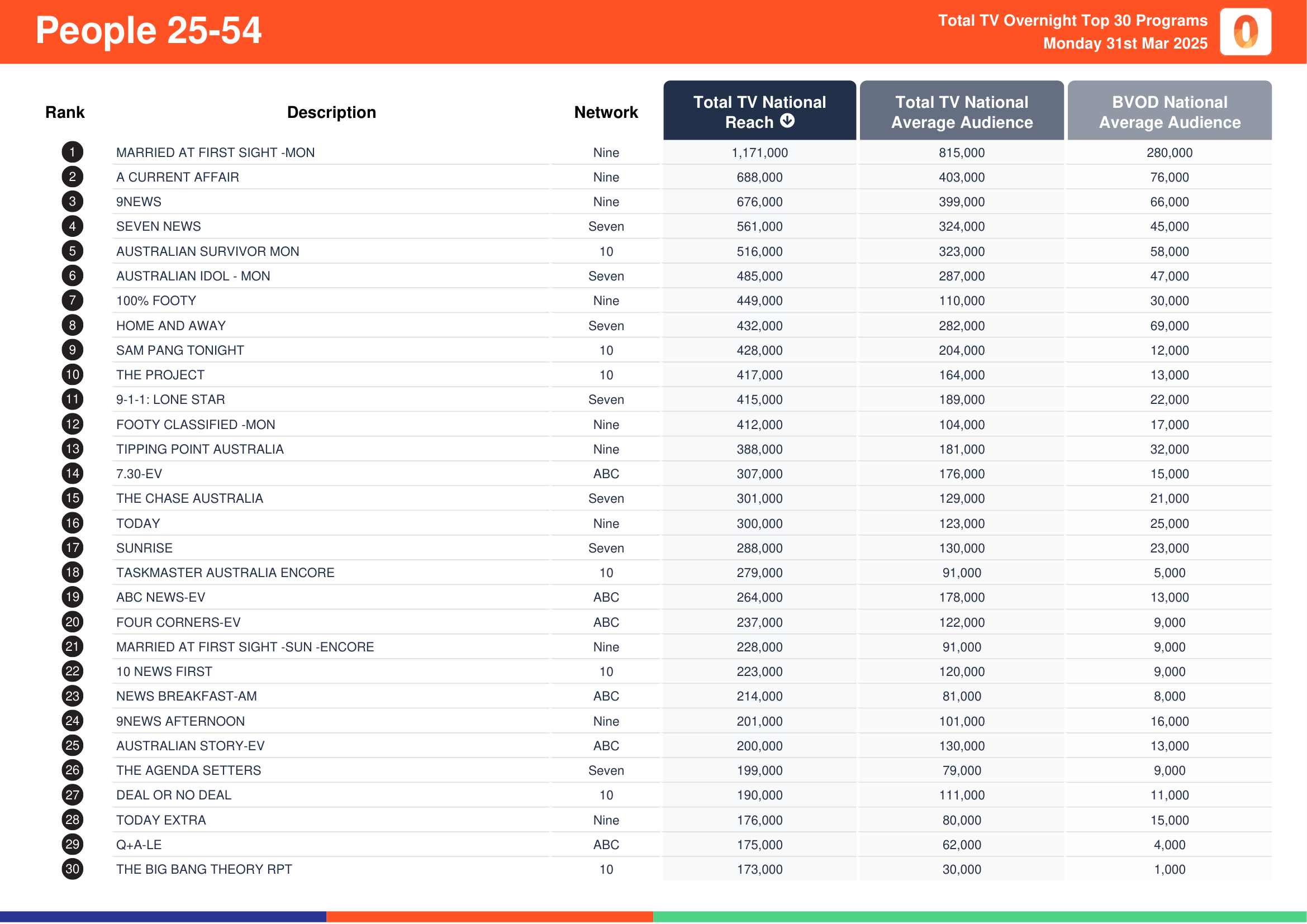
People 25-54 31 March 2025.
People 16-39
Nine’s Married At First Sight:
• Total TV national reach: 598,000
• National Audience: 416,000
• BVOD Audience: 184,000
Nine’s A Current Affair:
• Total TV national reach: 323,000
• National Audience: 182,000
• BVOD Audience: 43,000
Nine’s 9News:
• Total TV national reach: 295,000
• National Audience: 156,000
• BVOD Audience: 34,000
10’s Australian Survivor:
• Total TV national reach: 236,000
• National Audience: 155,000
• BVOD Audience: 33,000
Nine’s 100% Footy:
• Total TV national reach: 217,000
• National Audience: 52,000
• BVOD Audience: 18,000
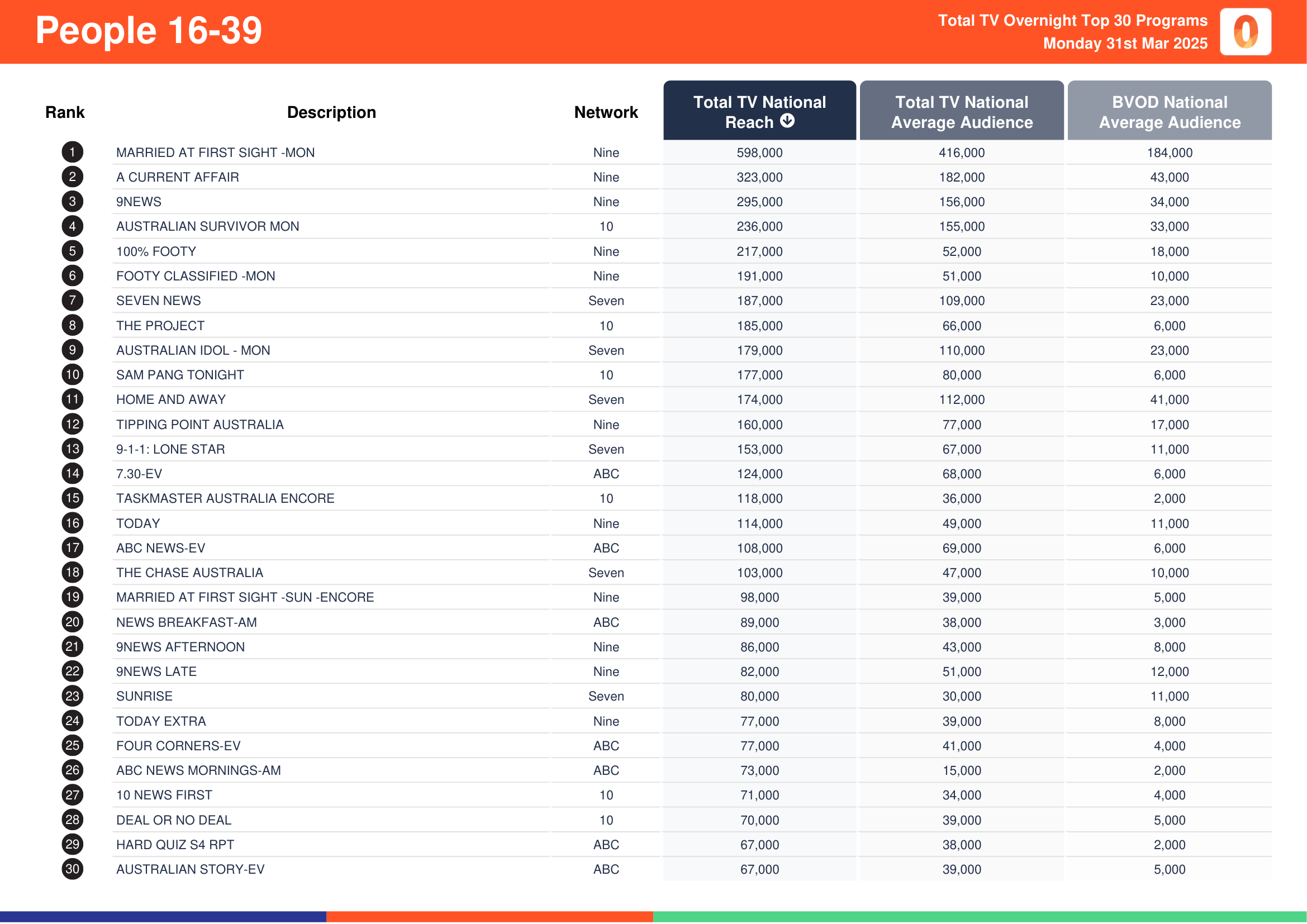
People 16-39 31 March 2025.
Grocery Shoppers 18+ TV Ratings
Nine’s Married At First Sight:
• Total TV national reach: 2,164,000
• National Audience: 1,401,000
• BVOD Audience: 362,000
Seven’s Seven News:
• Total TV national reach: 1,771,000
• National Audience: 1,128,000
• BVOD Audience: 71,000
Nine’s 9News:
• Total TV national reach: 1,680,000
• National Audience: 1,065,000
• BVOD Audience: 103,000
Nine’s A Current Affair:
• Total TV national reach: 1,540,000
• National Audience: 999,000
• BVOD Audience: 109,000
Seven’s Australian Idol:
• Total TV national reach: 1,278,000
• National Audience: 798,000
• BVOD Audience: 77,000
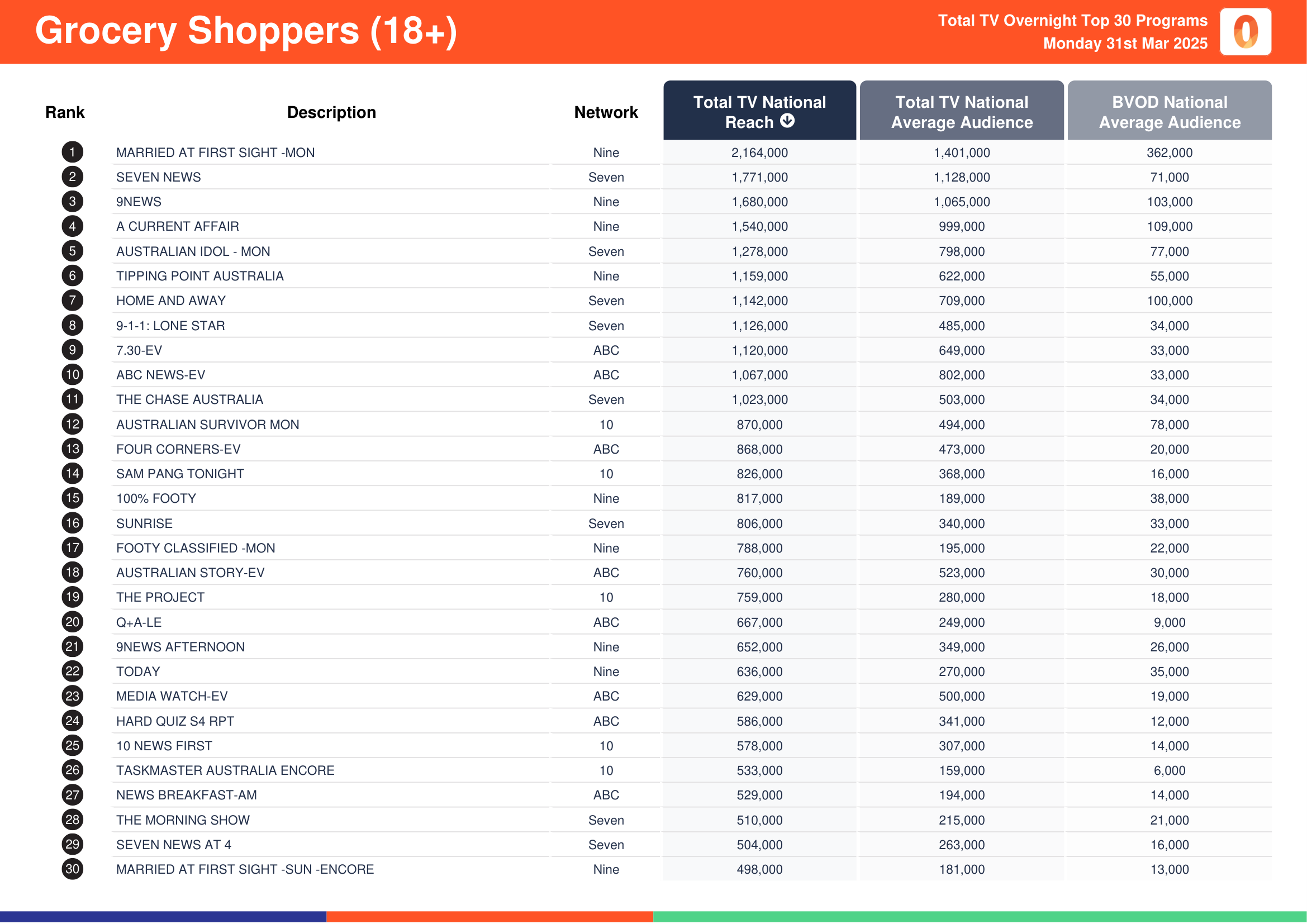
Grocery Shoppers (18+) 31 March 2025.
Data © OzTAM and Regional TAM 2025. Not to be reproduced, published or communicated (electronically or in hard copy) in whole or in part, without prior written consent of OzTAM and Regional TAM.
Journalism
Walkley winner Nick McKenzie breaks up road rage incident
The Walkley-decorated reporter stepped in to restrain a chair-wielding man during a chaotic road rage incident in Brunswick on Monday afternoon.
As Daanyal Saeed writes in Crikey, McKenzie was walking nearby and intervened before the confrontation turned violent, detaining the man solo until police arrived.
Former FT editor Gwen Robinson remembered as a force in global media
As Edward Luce writes in The Australian Financial Review, that as comment editor, she had a rare knack for pulling focus, from CEOs, diplomats, and global figures alike, with a directness only a seasoned foreign correspondent could deliver.
Before her FT stint, Robinson built a heavyweight career across Asia, including roles as a senior editor at Nikkei Asia and contributing to the Australian Financial Review.
Brands
Virgin Australia prepares for takeoff with ASX return on the horizon
As Robyn Ironside reports in The Australian, new CEO Dave Emerson, barely weeks into the job, is leading the pitch, part meet-and-greet, part market warm-up.
The private equity firm is riding high on strong half-year earnings of $439 million, a bullish aviation sector, and a recent $750 million deal with Qatar Airways for a 25% stake.
Streaming
How Max plans to win with less content
This approach is a key differentiator in the increasingly crowded streaming market, where competition from global and local players is fierce, and aggregation is popular.
As president of Warner Bros Discovery for the APAC region, James Gibbons has launched Max across diverse markets, including Japan and India, but says Australia is a particularly strong market for Max’s premium content offering.
Agencies
Mars United Commerce: ANZ retail media is maturing fast
The report aims to help brands build a clear understanding of the market dynamics influencing retail media.
Cameron Porter, commerce planning director at Mars United Commerce ANZ, told Mediaweek the report card reflects a category that is “maturing fast”.
Music
Troye Sivan and Kevin Parker lead APRA Awards
As Lars Brandle writes in Rolling Stone, both artists have enjoyed global success not just on streaming platforms, but through licensing and sync deals that boost brand visibility and reach.
Producer Styalz Fuego leads the field with four nominations, including for his work with Jessica Mauboy and Jason Derulo.
Social media
Aussie YouTuber ordered to pay $350k in defamation case over Donkey Kong claims
As Josh Taylor writes in The Guardian Australia, the judgment centred on a 2021 video in which Jobst linked Mitchell to a fellow YouTuber’s suicide, claims the court ruled were “recklessly” false.
Mitchell, a high-profile figure in retro gaming with Guinness-recognised records in Donkey Kong and Pac-Man, successfully argued the video damaged his reputation and career.
Entertainment
Sony and Sam Mendes line up The Beatles for a four-film theatrical ‘binge’
As Dan Condon reports for ABC News, the cast includes Paul Mescal (McCartney), Harris Dickinson (Lennon), Joseph Quinn (Harrison), and Barry Keoghan (Starr).
The films have been dubbed “the first binge-able theatrical experience” by Mendes.
Television
ABC Entertains finds its audience, but not yet its identity
As David Knox writes in TV Tonight, The channel’s mix of nostalgia-driven reruns, light entertainment, and international pickups is broad, but lacks a headline Australian commission to anchor its offering.
While first-run titles like Louis Theroux Interviews and Would I Lie To You? bring global recognition, most content is repurposed from other ABC platforms.
Retail
Retail spending holds steady, but recovery still out of reach
As Sean Cao writes in Inside Retail, while not a breakout result, it’s the second month of modest growth, buoyed by gains in ‘other retailing’ (up 5.5%) and food (up 4.08%).
Cosmetics, sports gear and cafés are pulling their weight, but clothing and accessories remain flat.

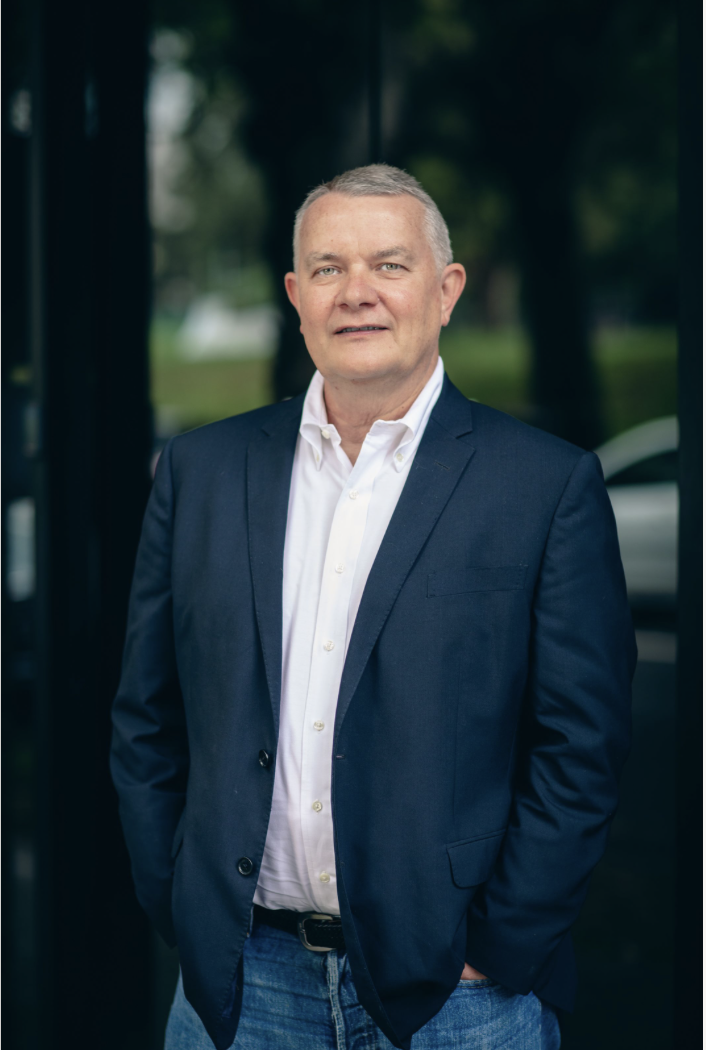
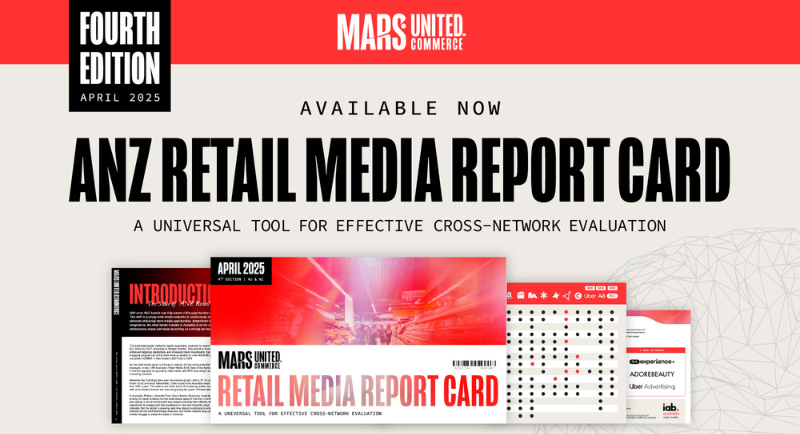
![Guideline SMI AU: Feb 2025 Ad spend trends. [click to expand.]](https://images-r2.thebrag.com/mw/uploads/2025/04/Guideline-SMI-AU-Feb-2025-Adspend-Trends.png)